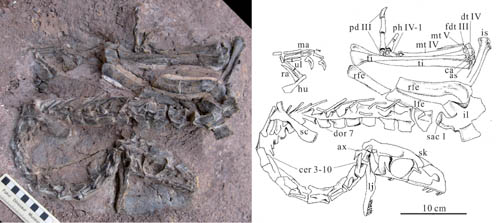| Location: Home > Research > Research Progress |
| First Asian Coelophysoid Dinosaur Discovered in Lufeng, Yunnan, China |
|
Coelophysoid dinosaurs represent the earliest major radiation of neotheropods. These small-to-medium-sized agile bipeds lived throughout much of Pangaea during the Late Triassic–Early Jurassic. However, despite the well-documented discoveries of coelophysoids in North America and Africa, the coelophysoid material that has previously been reported from Asia is limited to two specimens comprising only limb fragments. Dr. YOU Hailu, the Institute of Vertebrate Paleontology and Paleoanthropology of the Chinese Academy of Sciences (IVPP), and his team reported a new coelophysoid dinosaur: Panguraptor lufengensis gen. et sp. nov. from the Lower Jurassic Lufeng Formation of Yunnan Province, China online October 16 in the journal of Zootaxa, and it represents the first well-preserved coelophysoid in Asia. The new taxon is represented by a well-preserved skeleton, including the skull and lower jaw, the presacral vertebral column and partial ribs, the right scapula, a partial forelimb, part of the pelvic girdle, and an almost complete hind limb. It is distinguished from other coelophysoid theropods by the unique combination of the following three character states: 1) diagonal (rostrodorsal-caudoventral) ridge on lateral surface of maxilla, within an-torbital fossa, 2) elliptical, laterally facing fenestra caudodorsal to aforementioned diagonal ridge, and 3) hooked cranio-medial corner of distal tarsal IV. Cladistic analysis recovers Panguraptor lufengensis deeply nested within Coelophysoidea as a member of Coelophysidae, and it is more closely related to Coelophysis than to “Syntarsus”. This discovery provides fresh evidence supporting the hypothesis that terrestrial tetrapods tended to be distributed pan-continentally during the Early Jurassic. Lufeng is the most important birthplace for Chinese dinosaur research, and preserves one of the best dinosaur faunas in the world. At least 16 Early Jurassic dinosaur species has been named in Lufeng and its neighbouring area since C. C. Young 1941’s paper on Lufengosaurus huenei. However, most of these dinosaurs belong to sauropodomorphs, the discovery of Panguraptor shows the potential of pursuing more other kinds of dinosaurs in this area. More information: YOU, H.-L., AZUMA, Y., WANG, T., WANG, Y.-M. & DONG, Z.-M. (2014) The first well-preserved coelophysoid theropod dinosaur from Asia. Zootaxa, 3873(3), 233-249.
Fig.1 Panguraptor lufengensis You et al., 2014 (Image by YOU Hailu) |

